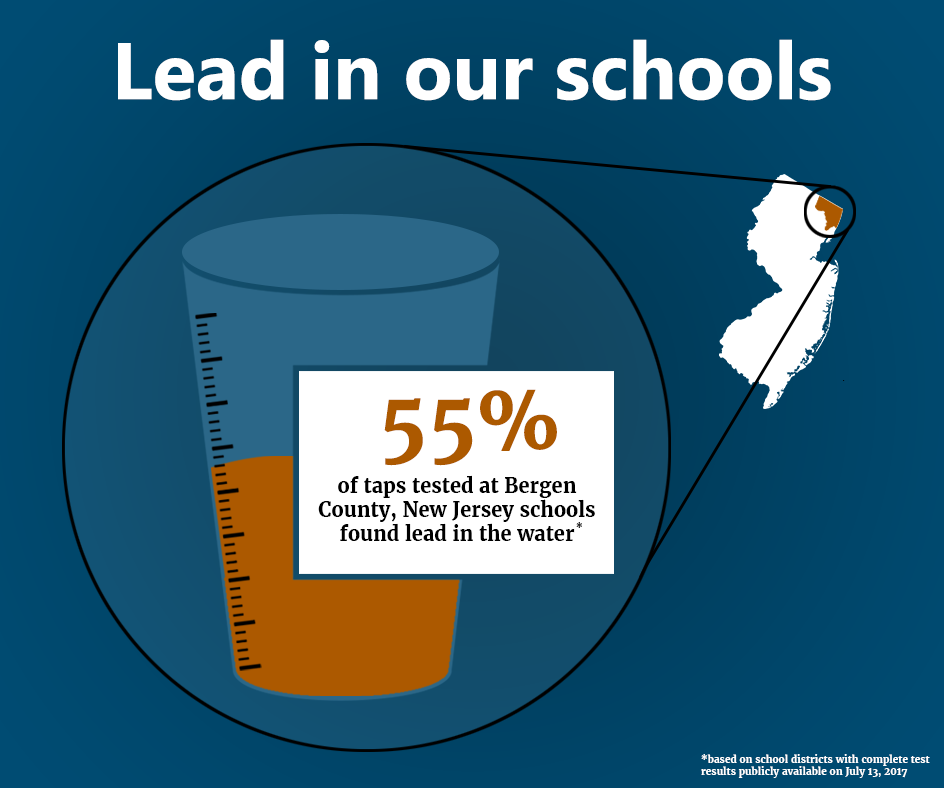Get the Lead Out Back to School Toolkit
Our children need safe drinking water – especially at their schools. Unfortunately, lead is contaminating drinking water at schools and pre-schools across the country, including here in New Jersey. This “Back to School” toolkit is designed to help parents, teachers and school officials get the facts on lead in drinking water and make the case for strong local action to ensure safe drinking water at school.

Downloads
Environment New Jersey Research & Policy Center
Factsheet on Lead in School Drinking Water
The Problem
In the wake of the tragedy in Flint, Michigan, we now know the toxic threat of lead in drinking water extends to thousands of communities across the country. In fact, lead is even contaminating drinking water in schools and pre-schools – flowing from fountains and faucets where our kids drink water every day.
Lead is highly toxic, especially for children
A potent neurotoxin, lead affects how our children learn, grow, and behave. According to EPA, “In children, low levels of [lead] exposure have been linked to damage to the central and peripheral nervous system, learning disabilities, shorter stature, impaired hearing, and impaired formation and function of blood cells.”[1]
There is no safe level of lead.
“EPA has set the maximum contaminant level goal for lead in drinking water at zero because lead is a toxic metal that can be harmful to human health even at low exposure levels.” In fact, medical researchers estimate that more than 24 million children in America will lose IQ points due to low levels of lead.[2]
Lead is contaminating drinking water at schools.
As more schools test their water for lead, they are finding widespread contamination. In Bergen County, the most populous county in New Jersey, 55% of the taps in schools with available data found lead contamination in the water. In Massachusetts, for example, roughly half of 66,000 taps tested at schools had lead in their water (as of August 4, 2017). Schools’ water is laced with lead in all kinds of communities – urban neighborhoods, rural towns, and affluent suburbs as well.
In all likelihood, the confirmed cases of lead in schools’ water are just the tip of the iceberg. Any school built before 2014 is likely to have significant lead in its pipes, plumbing, and/or fixtures. And where there is lead, there is risk of contamination.
Solutions
- Install Filters Now: Installing filters certified to remove lead is an easy, low-cost step schools can take to begin protecting children immediately. Filters should be installed and maintained on all faucets and fountains used for cooking or drinking in schools.
- Get the Lead Out: replacing pipes, plumbing, fountains and/or fixtures that contain lead is the most effective, permanent solution to prevent contamination of the water our children drink at school (or elsewhere).
- Remove Lead Service Lines: if the pipe connecting your school (or home or child care center) to the water main in the street is made of lead, that lead service line is likely to be the largest single source of water contamination. Have it replaced as soon as possible.
- Doctor’s Orders – 1 part per billion (ppb): The American Academy of Pediatrics recommends that schools keep lead concentrations in water no greater than 1 ppb. Taps used for drinking or cooking that test above 1 ppb of lead should be shut off until remediated.
- Ace the Test: regularly test all outlets used for drinking or cooking, using proper sampling methods that are more likely to detect lead contamination.
- Communicate: plans and actual steps taken to prevent lead contamination, along with all test results, should be made easily accessible (including online) to parents, teachers, and the public. Outlets should clearly indicate when filters are due to be replaced.
Understanding test results and limitations
In some communities, schools are already testing water for lead. In others, local officials might want to see testing results before taking action. Either way, here is what you should know:
- Lead corrosion is highly variable. As a result, tests sometimes fail to detect lead – or the full extent of lead – in water, especially when sampling is done improperly.
- Share all your work with the class. Sometimes officials or the media only report lead levels in water that exceed 15 (or 20) parts per billion (ppb). But there is no safe level of lead for children. Ask to see all test results detecting any level of lead in the water.
- Cheating on the test? Contamination tends to be higher the longer water sits in contact with lead-bearing pipes or fixtures. So samples taken after flushing of the system, or even regular water use, are unlikely to detect the full extent of lead contamination at school.
- Act now to protect children’s health. We already know that wherever there is lead in a water delivery system, there is a risk of contamination. Schools need not wait for test results before taking action to protect our children’s health.
[1] U.S. Environmental Protection Agency, “Basic Information about Lead in Drinking Water,” EPA.gov, updated December 2016, accessible at https://www.epa.gov/ground-water-and-drinking-water/basic-information-about-lead-drinking-water.
[2] American Academy of Pediatrics, Prevention of Childhood Lead Toxicity, July 2016, page 4, available at http://pediatrics.aappublications.org/content/pediatrics/early/2016/06/16/peds.2016-1493.full.pdf.
